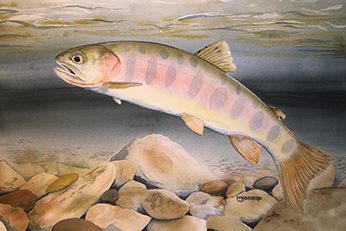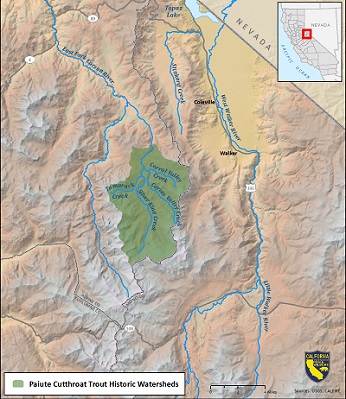Oncorhynchus henshawi seleniris
 © Mark Jessop, all rights reserved.
© Mark Jessop, all rights reserved.
 Map of Paiute cutthroat trout historic watersheds. (click/tap to enlarge)
Map of Paiute cutthroat trout historic watersheds. (click/tap to enlarge)
Distribution and Habitat
Native to Silver King Creek and tributaries in the headwaters of the East Fork Carson River drainage.
The historic range of Paiute Cutthroat Trout (PCT) includes eleven miles of stream habitat in Silver King Creek and its tributaries, from Llewellyn Falls downstream to a steep gorge section with a series of natural waterfalls located upstream of Snodgrass Creek.
PCT were introduced into Silver King Creek above Llewellyn Falls (upstream of their historic range) in 1912 by Basque sheep herders. To create additional refuge populations, PCT were introduced by various individuals and the California Department of Fish and Wildlife (CDFW) into other headwater tributaries within the Silver King Creek watershed, as well as four stream systems outside that basin.
Threats
Past habitat degradation caused by sheep and cattle grazing was a significant threat to the PCT. Cattle grazing was ceased by the U.S. Forest Service (USFS) in 1994. To protect this subspecies and its habitat, grazing is no longer allowed in the upper Silver King Creek basin above Snodgrass Creek.
The introduction of non-native trout into their historic range was a major cause of the PCT’s decline. Five different trout species have been moved into and around the Silver King drainage, including PCT, Lahontan Cutthroat Trout, California Golden Trout, Rainbow Trout, and Brook Trout. PCT were extirpated from their historical habitat due to introduced trout but exist in formerly fishless areas of the Silver King Creek drainage and four out-of-basin watersheds above fish passage barriers.
PCT is one of the most imperiled native fish in California, due to loss of genetic diversity and habitat fragmentation. Evidence of genetic diversity loss has been found in all PCT populations. They are all completely isolated from each other, so there can be no genetic exchange or recolonization after a catastrophic event, such as a large forest fire. Current populations are small, and isolated by waterfalls which are barriers to fish migration. This puts them at risk of hybridization with non-native trout and exposes them to the harmful effects of wildfires, drought, and climate change. In short sections of streams (called “reaches”), both the population size and habitat diversity may be inadequate for the species to survive, long-term.
Historically, recreational fishing was a threat to PCT. Because small streams are vulnerable to overharvest, recreational fishing for PCT has been closed in the Silver King Creek drainage since 1934.
Conservation and Management
Restoration efforts have occurred in the Silver King Creek basin for more than 60 years and the PCT populations are monitored annually. To increase their protection, progeny of the 1912 shepherds’ transplant were planted in other fishless waters of the Sierra Nevada, outside the species’ historic range, creating out-of-basin refuge populations.
The Paiute Cutthroat Trout Restoration Project was developed to eliminate threats from non-native fish, restore the PCT to its historical habitat, and ensure the minimum habitat requirements for long-term survival. The PCT is a federally-listed threatened species, and this restoration work is a major component of the recovery effort. The plan to remove non-native fish below Llewellyn Falls was implemented from 2013 through 2015. During this phase of restoration project, the stream was treated with rotenone (a piscicide) to remove non-native trout from Silver King Creek and associated tributaries between Snodgrass Creek and Llewellyn Falls.
Chemical treatment was the preferred alternative identified in the Paiute Cutthroat Trout Restoration Project Final EIR/EIS. Rotenone is a naturally occurring chemical compound derived from the roots of tropical plants in the bean family. Rotenone compounds have been used for centuries, all over the world, to stun and kill fish. Rotenone is used successfully throughout the U.S. as a management tool to eliminate invasive fishes and restore native populations. The U.S. Environmental Protection Agency has concluded that rotenone use for fish control does not present a threat or risk of unreasonable adverse effects to humans or the environment. For more information on rotenone visit the American Fisheries Society Rotenone Stewardship Program.
Following the chemical treatment project, the CDFW and its partners conducted a three-year evaluation (2016 through 2018) to ensure the treatment was successful. CDFW and our partners—the U.S. Fish and Wildlife Service (USFWS) and USFS begin returning PCT to Silver King Creek today—September 18, 2019. PCT are already colonizing restored habitat from upstream sources, but restocking will help reestablish the population more quickly.
This restoration project will expand the population’s protected stream habitat by approximately 11 miles and serve as a buffer against extinction from threats such as wildfire, drought, and disease. Since the amount of habitat for the fish will almost double, a much larger population of PCT is expected to exist in the future. A larger population will be more resistant to the genetic threats that small, isolated populations face over time. When the species is restored to its historic range, we anticipate that a stream segment could be opened to a special regulation fishery for anglers to catch and release PCT.
The recovery of PCT is a multi-agency collaborative effort guided by the U.S. Fish and Wildlife Service Revised Recovery Plan for the Paiute Cutthroat Trout (PDF). The CDFW is committed to continuing our partnership with the USFWS and USFS in the restoration and annual monitoring of PCT to ensure this species persists into the future.
Species Status
PCT were one of the first animals in the nation to be listed as Endangered in 1967 under the Federal Endangered Species Preservation Act of 1966. To facilitate recovery actions, in 1975 they were downgraded to Threatened under the Endangered Species Act of 1973.